
Sign our guestbook
View our guestbook

|
of a Canadian composer of opera 1892-1935 |
His youth
Early musical works
The opera
Jean-Marie
L'Intendant Bigot, the historical Canadian grand opera created in Montreal in 1929
Mademoiselle de Lanaudi´┐Żre, an unpublished opera
His regret: not being able to dedicate his life to his musical pursuits...
French extensive homepage |
|
Early musical talent
Ulric Voyer was born in Quebec City, July 5, 1892. He had undeniable musical talent that manifested at an early age. This amusing anecdote is revealing : Ulric was only five years old, his sisters were not in the house, and his father was upstairs. Ulric was amusing himself on the piano. In fact, he already played the piano well enough to confuse his father who, entering the living room, was surprised to find that it was Ulric who was playing the piano and not one of his sisters. Ulric's sisters were learning how to play the piano, but Ulric was not. Was Ulric gifted with perfect pitch and able to play by ear? Studies and musical education Ulric Voyer studied at the Saint-Roch College in Quebec City. He first studied music with Wallace, and then at Saint-Roch's with Giffard's organist, M. Lefran´┐Żois. In the company of Edmond Trudel, he studied piano with Professor Hudson, and he studied organ and harmony in Montreal with Leon Dessane and M. Descarries. At that time, it was difficult to find instructors who taught orchestration in Quebec City, so he taught himself, learning from books that he purchased directly from Europe, like the Traite d'harmonie by Rimsky-Korsakoff, Technique de l'orchestration moderne by Widor, and the Traite pratique d'instrumentation et d'orchestration symphoniques by Ithier.
His passion for the stage and theatre In his personal diary, Ulric indicates that even while he was young, he was a lover and fan of theatre, and he rarely missed any performances in Quebec City. La boisson: Ulric created La boisson as early as 1907 or 1908. This play consists of three acts with twelve scenes, the manuscript of which is kept in the family archives. This play was presented many times in Quebec City and was broadcasted by a local radio station, CHRC, after his death. Triste r´┐Żalit´┐Ż: Ulric set aside the theatre for a while in order to pursue his studies and to teach music. He did not compose again until 1923. Triste r´┐Żalit´┐Ż was presented at the same time as excerpts from the opera Jean-Marie. The play summary indicates this play is an adaptation of La boisson. |
Early musical works
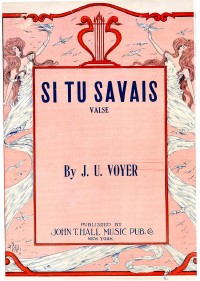 |
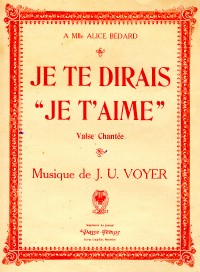 |
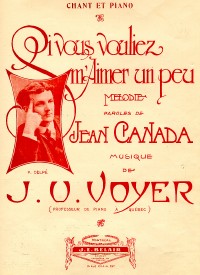 |
|
Early compositions and musical publications
The first musical compositions and early musical works date from 1911 to 1915, when Ulric was between 18 and 22 years old. Some of the hand-written pages of that period contain a series of waltzes composed on January 17, 1911. In 1912, he composed Petite amie, a "bluette," a short, unpretentious musical work. Prends garde ´┐Ż l'amour - Valse chant´┐Że was published in 1913, followed by publication in the United States of: Si tu savais, by John T. Hall Music in 1914. Also created at that time: ´┐Ż Mlle Alice B´┐Żdard: Je te dirais 'je t'aime', a waltz published in Montreal under the amusing assumed name of Jean Canada (lyrics), by the publisher, ´┐Żditions Le Passe-temps. Mlle A. B.: Si vous voulez m'aimer was published between 1913 and 1914.
First operas La Duchesse en sabots and Petit-mouton were composed in the early 1920s. La Duchesse en sabots, a comic opera consisting of one act with 45 walk-on actors, was presented in Quebec City as a benefit performance for the construction of the Church of Saint-Fran´┐Żois d'Assise. This opera was performed on Monday, November 8 and Tuesday, November 9 of 1920. We cannot determine the original contribution of Ulric Voyer to this work because it was adapted from Les chaussons de la duchesse Anne, a comic opera consisting of one act, initially composed by Ch. Le Roy-Villars. Andre Lesot, bookseller and editor, published the eleventh edition of the libretto in Paris in 1896. Petit-mouton, a comic opera in four acts, consists of 144 pages of hand-written musical orchestration. This original work was composed between 1920 and 1923, and is kept in the family archives along with violin and song scores. Not much is known about this work, as Ulric did not write informative notes about this piece. |
|
The year 1923 saw the presentation of excerpts from the opera Jean-Marie, a comic opera in four acts. Two performances were conducted in Quebec City on April 10 and 11 of 1923. The program and fifteen musical scores are kept in the family archives. The local press, Le Soleil and L'Action catholique, reported that this work was 'richly harmonized' and 'of a surprising truth and originality,' and was well received. The libretto was the result of close collaboration with Alfred Rousseau, and the performances were under the direction of F.-X. Mercier. The family archives contain the scores for tenors, baritones, basses, and soprano, along with the scores for the piano, double bass, violin, clarinet, F horns, and the oboe. |
|
The opera L'Intendant Bigot
The most famous work of J. U. Voyer was the opera L'Intendant Bigot. It was performed five times. Two performances were held in Montreal on February 5 and 7 of 1929 at the theatre house Monument National, under the musical direction of Albert Roberval. Three additional performances were presented in Quebec City on March 22 and 23 of 1929 at the Auditorium de Quebec, which is now the Capitol Theatre, under the musical direction of Edmond Trudel and with the patronage of the Honorable L.-A. David. Initially, the opera was to be presented only in Montreal. Following the success in Montreal, plans were made for one performance in Quebec City. In the end, three performances were presented at the Auditorium de Qu´┐Żbec, with almost the same cast of renowned artists who had performed in Montreal: Arnold Becker in the title role, Louis Gravel, Paul Trottier, C. E. Brodeur, Marie-Rose Descarries, and Caro Lamoureux. The three manuscripts of orchestrated music and a piano-voice reduction are bound and preserved in the family archives. Many scores of the opera, with the first act occurring on the heights of the city of Beauport, near Quebec City, are included in these manuscripts. Also included: double bass, cello, violins, clarinet, bassoon, cornet, horns, oboe, trombone, viola, and flute. Many copies of the libretto, created in collaboration with Alfred Rousseau, and copies of the program for the performances, both in Montreal and Quebec City, are also kept in the archives. More than fifty newspaper articles reported the event, including Montreal's La Presse and Quebec City's Le Soleil and L'´┐Żv´┐Żnement, etc. The opera was presented by the Soci´┐Żt´┐Ż canadienne d'op´┐Żrette, who produced and presented it as the first Canadian grand opera. In a letter that he sent to the composer and that was later reprinted in the program, Honor´┐Ż Vaillancourt, writing in the name of the Soci´┐Żt´┐Ż as its director general, stated that Ulric Voyer was 'the first Canadian to produce a lyrical work with the scenes created in the form of an opera.' The Encyclopedia of Canadian Music, published in 1993, mentioned the work without considering the opera L'Intendant Bigot as the first Canadian opera.
|
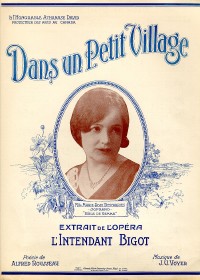 |
First
recordings of excerpts from L'Intendant Bigot
A 78 rpm recording of excerpts from the opera L'Intendant Bigot was made in the thirties: Romance du Marquis, sung by C. E. Brodeur and Dans un petit village by Jeanne Maubourg-Roberval. Several copies of the printed music, as well as several scores, are kept in the archives and include the score for the orchestra conductor written for soprano, flute, oboe, clarinet, B bassoon, F horns, B trumpet, trombone and violin. A second 78 rpm recording of 1,000 copies, sung by Marie-Rose Descarries, sold quickly. The May 1929 edition of the Montreal musical journal, La Lyre, emphasized that it 'set a sales record never before achieved by a Canadian in such a short period of time.' The same excerpt, Dans un petit village, was published in Montreal. Audrie Rubanni was so charmed by this piece, she included it in her performance at the New York Steinway Concert Hall on October 30, 1930. The performance included works of Debussy, Faur´┐Ż, and Rup´┐Żs, and had been advertised in the October 30th edition of the New York Times. A copy of the performance brochure is maintained in the family archives. |
|
The opera Mademoiselle de Lanaudi´┐Żre
An unpublished work kept in the family archives is Mademoiselle de Lanaudi´┐Żre, a comic opera in three acts and four scenes. There are two bound manuscripts consisting of 685 hand-written pages of orchestra music, composed in collaboration with G.E. Lefebvre, that are kept in the archives. Also kept is the piano-voice reduction of this work, the proofs of the libretto, and 36 scores: tenor, baritone, bass and soprano's; clarinet, cornet, violin, flute, bassoon, trombone, double bass, cello, horn, and oboe. This work was written in collaboration with Henri Deyglun, author of the libretto, and slated for performance. Forward movement was halted due to the untimely death of the composer, Ulric Voyer. The project was very close to completion, as indicated by the handwritten memorandum that indicated: 'the income of each performer for their participation at the presentation of Mademoiselle de Lanaudi´┐Żre, under the musical direction of Mercier-Gingras.' M. Athanase Guy signed a contractual agreement in Quebec City on October 20, 1931. This agreement stipulated that the main character was to be played by Marthe Lapointe, the role of Salaberry, by Antonio Lamontagne, and artistic direction by Jean Riddez. A document signed on June 4, 1932 by G. E. Lefebvre asserted that he verified the quality and accuracy of the orchestration. While the opera L'Intendant Bigot recalled France's abandonment of French Canada, Madame de Lanaudi´┐Żre expressed the relationship between the two halves of Canada. As Madame de Lanaudi´┐Żre states, 'We are good neighbors. We visit each other, and neither English nor French avoids the other, because from our good relations will rise a powerful nation.' |
His regret:
Not being able to dedicate his life
to his musical pursuits
|
Alice B´┐Żdard |
The
various occupations of J. Ulric Voyer
Ulric Voyer had every possible occupation in order to support his wife and eighteen children. He was a self-taught musician, piano instructor, clerk for the Municipal Court of Quebec City, first organist of the Saint-Fran´┐Żois d'Assise Church, shorthand instructor, playwright, and the manager of publicity for J.B. Renaud. In 1913, he married Alice B´┐Żdard, and they had eighteen children during twenty-one years of marriage, although three of the children died at an early age. As soon as the others were old enough, they were introduced to the world of music: Madeleine learned signing, Gaston learned the clarinet and oboe, Fran´┐Żoise learned the piano, and Gemma learned the violin.
|
|
Many musicians and friends regularly stopped by the house to play music and talk about music: Edmond Trudel, the orchestra conductor who led the opera L'Intendant Bigot in Quebec City, F.-X. Mercier, the orchestra conductor who led the presentation of excerpts from the opera Jean-Marie, G.-E. Lefebvre, another orchestra director and the head of the Cercle Philharmonique Haydn who later revised the opera Mademoiselle de Lanaudi´┐Żre, Jean Riddez of the Op´┐Żra de Paris. The librettist Henri Deyglun of the Soci´┐Żt´┐Ż des auteurs dramatiques de Paris, and the radio broadcaster Alfred Rousseau, who wrote the libretto of the opera Jean-Marie, the opera L'Intendant Bigot, and the livret of the comic opera Coup d'soleil by Omer L´┐Żtourneau and Honor´┐Ż Vaillancourt of the Soci´┐Żt´┐Ż canadienne d'op´┐Żrette and so many other. How many other singers and musicians from Quebec City knew Ulric Voyer? There were some evenings during the early thirties when there seemed to be a concert being held on 13th Street in Quebec City. The priests of the Coll´┐Żge de Saint-Fran´┐Żois d'Assise would gather together with the rest of the neighborhood in the schoolyard to listen. On those evenings, they could hear the sounds emanating from the magnificent piano that was the pride of Ulric Voyer and that had once belonged to Joseph V´┐Żzina, the late composer and orchestra conductor. Ulric Voyer was active in broadcasting circles: he co-founded the radio station, CHRC, with Narcisse Thivierge, and he was the musical director of the station in 1931, and continued in that post until his death. Once a month, he hosted a one-hour live broadcast of comic opera or a classical work. He was so in love with music that in 1913 he wrote that he had decided to dedicate his life to music. But that was not an easy task in Quebec at that time. Ulric was only able to devote his spare time to his musical passion for composing operas, in spite of ill health that caused him to blackout, and heart problems evident even in his youth.
Tragic and untimely death Ulric Voyer, composer, died at the age of 42 on January 8, 1935. As a head writer from the Quebec City newspaper Le Soleil reported, using the assumed name of L'oncle Gaspar, 'The death of Ulric Voyer created an easily understood commotion throughout the city. Everyone, he wrote, was his friend. Someone always stopped him on the street to discuss music. And many others were accustomed to stopping him to discuss business because, having been one of the most highly thought of employees at the Maison J.-B. Renaud for twenty years, people valued his opinion and knowledge. But his passion was for music, and he always regretted that he was unable to dedicate his entire life in pursuit of that passion.'
Gilles Bizier, Quebec City, Canada. October 27, 1997 Translated June 1998 Edited by Michelle McKeeth and Pamela Cheers
|
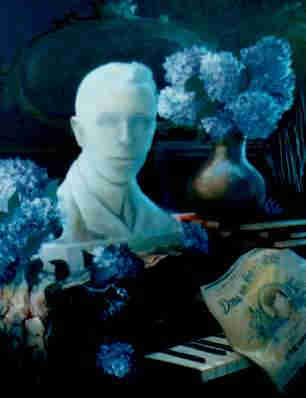
Top
E-Mail us at : [email protected]
or fill in the following ![]() form
form
Or write us to
|
1609 de la Capricieuse Phone : (418) 529-6501 |
´┐Ż 1997-2009, Society of Friends and Descendants of Ulric Voyer
Site r´┐Żalis´┐Ż par OPCA-internet
Site created June 15, 1998; updated April 9, 2004
URL: http://www.geocities.com/voyerju/biograng.html